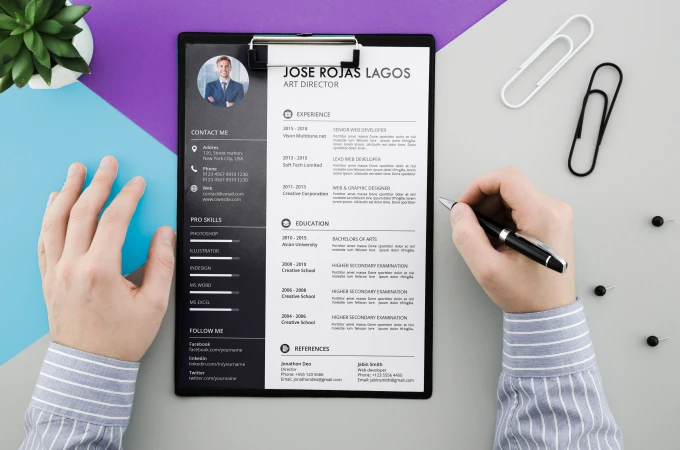In today’s competitive job market, ensuring that your resume stands out can be a daunting task. However, with the advancement of technology, employers are increasingly relying on Applicant Tracking Systems (ATS) to screen resumes before they even reach human eyes. If you want your resume to make it past the ATS and into the hands of hiring managers, it’s crucial to optimize it with the right keywords, formatting, and structure. In this blog, we’ll discuss how to build your resume with ATS optimization in mind, ensuring that your application has the best chance of landing you that coveted job.
What is ATS?
ATS, or Applicant Tracking System, is software used by recruiters and employers to manage the recruitment process. It helps screen resumes based on specific keywords, skills, and other criteria to quickly filter out unqualified candidates. As a job seeker, understanding how ATS works can make a huge difference in getting your resume noticed. A well-optimized resume increases the likelihood of passing the ATS filter and landing an interview.
1. Choose the Right Resume Maker Tool
To kickstart your ATS-friendly resume, you first need the right tool. There are many resume creation tools available, but choosing the best one can make the difference between success and failure. A good resume maker can provide you with the templates and formatting options that make it easier to build your resume in a way that ATS will understand. These tools often offer pre-designed templates that are optimized for ATS and make the process much faster and simpler.
Using a resume builder allows you to create your resume quickly by filling in the necessary information while ensuring that the final product is formatted correctly. This will save you a lot of time compared to manually formatting your resume. Moreover, most resume builders offer tips and suggestions on how to make your resume more ATS-friendly, helping you align with best practices without any hassle.
2. Use Simple, Standard Formatting
ATS systems are designed to read and parse information from resumes, but they can struggle with overly complex formatting. While it’s tempting to create a visually striking resume with fancy fonts, graphics, or columns, these elements can confuse ATS and cause your resume to be rejected. To ensure your resume is ATS-compatible, stick to simple formatting.
Use a clean and easy-to-read font such as Arial, Calibri, or Times New Roman. Avoid using images, graphics, or tables, as ATS may not be able to parse this information correctly. For the best results, build your resume with clear headings, such as “Experience,” “Education,” and “Skills,” to help the ATS quickly identify important sections.
3. Optimize Your Resume with Keywords
One of the most important aspects of ATS optimization is using the right keywords. ATS software scans resumes for specific keywords related to the job posting. If your resume doesn’t include the right keywords, there’s a good chance it will be filtered out before it reaches the recruiter.
To create your resume with the right keywords, carefully read the job description and identify important terms that match your skills and experience. Focus on including relevant keywords in your work experience, skills, and qualifications sections. For example, if a job requires “project management” skills, make sure to mention this phrase in your resume if applicable.
Additionally, don’t just focus on the job title. ATS also looks for industry-specific terms, skills, and certifications. For instance, if the job requires knowledge of a specific software, like “Microsoft Excel,” include that in your resume if you have the experience.
4. Keep Your CV Simple with a CV Maker
While a resume and CV are not exactly the same, the principles of ATS optimization remain consistent. If you’re applying for jobs in academia or other industries where a CV is preferred, using a CV maker can be a changer. CV makers are specifically designed to help you format your CV in a way that’s easy to read for both ATS and hiring managers.
Similar to using a CV builder online for a resume, a CV maker provides a simple, streamlined interface to help you highlight your academic background, research, and professional experience in an ATS-compatible format. This is especially important for applicants in fields where a CV is the preferred document, such as in education, research, or science.
5. Highlight Relevant Experience and Skills
ATS scans resumes for relevant experience and skills, so it’s essential to structure your resume in a way that makes this information easy to find. Start with a strong summary or objective statement that clearly outlines your qualifications. In the experience section, focus on your most relevant work history, detailing specific accomplishments and quantifying results wherever possible.
Don’t forget to include a dedicated skills section, where you can list the technical and soft skills that align with the job description. Be sure to build your resume in such a way that the skills mentioned in the job posting are reflected in this section, as this will significantly increase your chances of passing through ATS filters.
6. Avoid Using Abbreviations
Although abbreviations can save space on your resume, ATS may have difficulty recognizing them. For example, if you’re listing a certification, don’t just write “PMP.” Instead, spell out “Project Management Professional (PMP)” to ensure that the ATS can identify the certification correctly.
When using industry-specific terms, be sure to write them out in full at least once and use the abbreviation later in your resume. This helps ensure that your resume is readable both by ATS and by hiring managers.
7. Test Your Resume with ATS
Once you’ve used a resume builder or cv builder online to create your resume, it’s a good idea to test it using an ATS simulator. These tools can show you how well your resume performs when parsed by an ATS, allowing you to make adjustments as necessary.
Several online services offer ATS testing, providing feedback on how your resume ranks in terms of keyword optimization, formatting, and readability. If your resume isn’t performing as well as you’d like, adjust your formatting or add additional relevant keywords to improve your chances.
Conclusion
Building an ATS-friendly resume is crucial for making sure your application doesn’t get lost in the shuffle. By using a reliable resume maker or cv maker, following best practices for formatting, and optimizing your content with relevant keywords, you’ll significantly increase your chances of passing through the ATS and catching the attention of hiring managers.
Whether you’re looking to build your resume for a new job or create your resume for an upcoming career change, remember that the goal is to make it easy for the ATS to read and identify your qualifications. By following the steps outlined in this blog, you’ll be well on your way to landing the job of your dreams.












